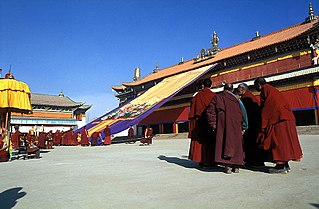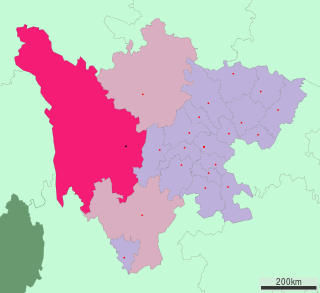
Tibet is a region in East Asia covering much of the Tibetan Plateau spanning about 2.5 million km2. It is the traditional homeland of the Tibetan people as well as some other ethnic groups such as Monpa, Tamang, Qiang, Sherpa, and Lhoba peoples and is now also inhabited by considerable numbers of Han Chinese and Hui people. Tibet is the highest region on Earth, with an average elevation of 5,000 m (16,000 ft). Located in the Himalayas, the highest elevation in Tibet is Mount Everest, Earth's highest mountain, rising 8,848 m (29,029 ft) above sea level.

The Jonang is one of the schools of Tibetan Buddhism. Its origins in Tibet can be traced to early 12th century master Yumo Mikyo Dorje, but became much wider known with the help of Dolpopa Sherab Gyaltsen, a monk originally trained in the Sakya school. The Jonang school was widely thought to have become extinct in the late 17th century at the hands of the 5th Dalai Lama, who forcibly annexed the Jonang gompas to his Gelug school, declaring them heretical.

Amdo is one of the three traditional regions of Tibet, the others being U-Tsang in the west, Kham in the east. Ngari in the north-west was incorporated into Ü-Tsang. Amdo is also the birthplace of the 14th Dalai Lama. Amdo encompasses a large area from the Machu to the Drichu (Yangtze). Amdo is mostly coterminous with China's present-day Qinghai province, but also includes small portions of Sichuan and Gansu provinces.
Tai Situpa is one of the oldest lineages of tulkus in the Kagyu school of Tibetan Buddhism In Tibetan Buddhism tradition, Kenting Tai Situpa is considered as emanation of Bodhisattva Maitreya and Guru Padmasambhava and who has been incarnated numerous times as Indian and Tibetan yogis since the time of the historical Buddha.

Ngawa or Aba town is the seat of Ngawa (Aba) County, within the Ngawa (Aba) Tibetan and Qiang Autonomous Prefecture in northwestern Sichuan, China. It is located on the Tibetan plateau at an elevation of 3,200 metres. The city is about 75 km from Jigdril, 254 km from Barkham (Ma'erkang) and 157 km from Mewa (Hongyuan).

Labrang Monastery is one of the six great monasteries of the Gelug school of Tibetan Buddhism. Its formal name is Genden Shédrup Dargyé Trashi Gyésu khyilwé Ling.

Tashi Lhunpo Monastery, founded in 1447 by the 1st Dalai Lama, is the traditional monastic seat of the Panchen Lama, and an historically and culturally important monastery in Shigatse, the second-largest city in Tibet.

Drepung Monastery, located at the foot of Mount Gephel, is one of the "great three" Gelug university gompas (monasteries) of Tibet. The other two are Ganden Monastery and Sera Monastery.

Ngawa Tibetan and Qiang Autonomous Prefecture, also known as Aba, is an autonomous prefecture of northwestern Sichuan, bordering Gansu to the north and northeast and Qinghai to the northwest. Its seat is in Barkam, and it has an area of 83,201 km2 (32,124 sq mi). The population was 919,987 in late 2013.

Dzogchen Monastery is one of the "Six Mother Monasteries" of the Nyingma tradition of Tibetan Buddhism. It is located in Kham within modern day Dêgê County, Garzê Tibetan Autonomous Prefecture, Sichuan, China.

Garzê Tibetan Autonomous Prefecture also known as Ganzi — is an autonomous prefecture occupying the western arm of Sichuan province, China, bordering Yunnan to the south, the Tibet Autonomous Region to the west, and Gansu to the north and northwest. It is sometimes spelled "Kardze" and "Garzin" by non-government sources.

Muli Tibetan Autonomous County is in the Liangshan Yi Autonomous Prefecture in the southwest of Sichuan province, China, bordering Yunnan province to the southwest. It is a remote, mountainous and forested region with few roads. The highest peaks are nearly 6000 metres in height. The trio of the sacred Konkaling mountains - Shenrezig, Jambeyang and Chanadorje in Yading Natural Park - lie to the west in Daocheng County, barely accessible by rough jeep track from Chabulang in northern Muli County.

Palpung Monastery is the name of the congregation of monasteries and centers of the Tai Situpa lineage of the Kagyu school of Tibetan Buddhism as well as the name of the Tai Situ's monastic seat in Derge, Kham. Palpung means "glorious union of study and practice". It originated in the 12th century and wielded considerable religious and political influence over the centuries.

Tongkor or Tongkhor Monastery, also known as Ganden Chokhorling or Dangar Gompa, is a Tibetan Buddhist monastery located in Zithang Town, Garzê County, Garzê Tibetan Autonomous Prefecture, Sichuan, China.

Garzê or Gānzī, is a town and county seat in Garzê County, Garzê Tibetan Autonomous Prefecture in western Sichuan Province, China. Despite Garzê Prefecture being named after the town, the prefecture capital is actually Kangding, 365 km to the southeast. As of 2010, Garzê was home to 16,920 inhabitants. Garzê is an ethnic Tibetan township and is located in the historical Tibetan region of Kham. It contains the 15th century Kandze Monastery, home to over 500 Gelugpa monks.
Sershul Monastery (སེར་ཤུལ་དགོན།) is situated on the Tibetan Plateau at an elevation of 4,000 metres (13,000 ft). The Tibetan Buddhist monastery is located in the Garzê Tibetan Autonomous Prefecture of Sichuan Province, near where the borders of the Tibet Autonomous Region and Qinghai Province meet.

Yarchen Gar, officially known as Yaqên Orgyän Temple, is a Tibetan Buddhist monastery of the Nyingma school, with an educational institute and residential community in western Sichuan province, China. The majority of its Tibetan and Chinese residents are nuns, leading to it being called the "City of Nuns". By the end of 2019, more than half of their residences had been demolished by Chinese authorities.

Kirti Gompa, is a Tibetan Buddhist monastery founded in 1472 and located in Ngawa, Sichuan province, in China, known as Kham. Numerous other associated Kirti monasteries and nunneries are located nearby. As of March 2011, the Kirti Gompa was said to house 2,500 monks. Between 2008 and 2011, mass arrests and patriotic re-education programs by Chinese authorities have targeted the monks, reducing the population substantially to 600 monks. The wave of Tibetan self-immolations began at Kirti Gompa.
The Tibetan rebellion of 1905 was a series of riots which the Tibetan lamas tortured and executed French Catholic missionaries, massacred Tibetan Catholic converts, assassinated officials of Qing China, attacked the riot-quelling Qing's army, and burned dozens of churches. This is considered one of the largest religious persecutions organized by the Tibetan lamas.

Li Jingquan was a Chinese Hakka politician and the first Party Committee Secretary of Sichuan following the establishment of the People's Republic of China in 1949. Considered by scholars to be one of Mao's most enthusiastic adherents, he took a hard line on land reform in Tibetan areas of Sichuan in 1956 and played a central role in the massive starvation of Chinese citizens in Sichuan province and Chongqing during the Great Leap Forward.















